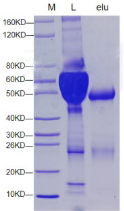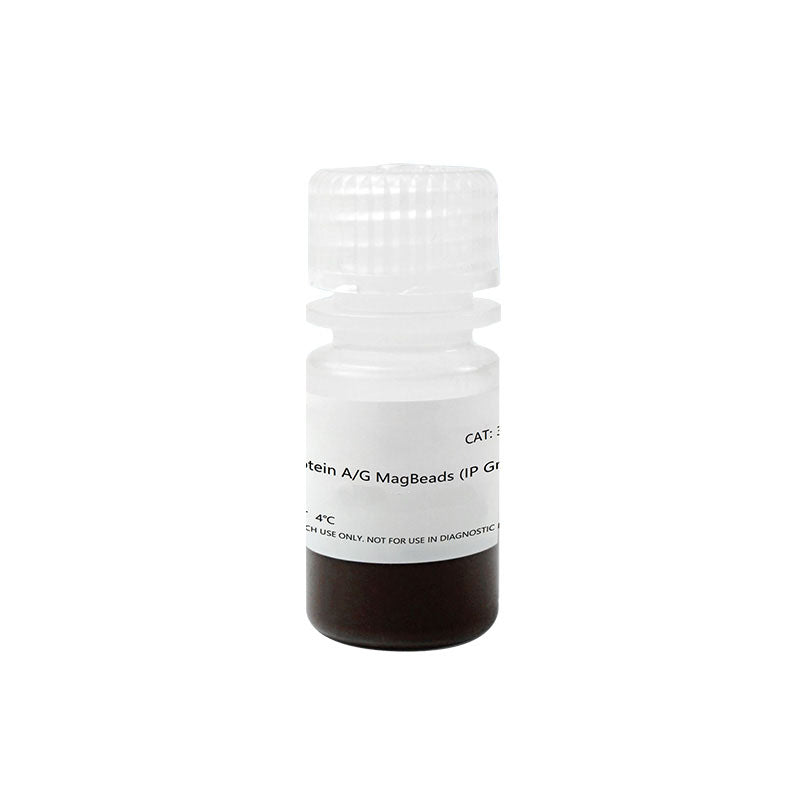Description
Protein A/G MagBeads use "nano-surface biotechnology" (S-TEC) to target Protein A/G onto the surface of superparamagnetic polymer microspheres with high density. It has higher antibody binding ability and very low non-specific adsorption rate of protein. One-step purification can isolate the antibody with purity >90% from the serum sample, which is simple and effective to use. Natural Protein A is a cell wall surface protein found in Staphylococcus aureus. Natural Protein G is a cell surface protein isolated from the genus G or C Streptococcus. Both have similar functions and bind most mammalian IgG by interacting primarily with the Fc region of immunoglobulin (Ig), but differ in their binding specificity. Protein A/G MagBeads covalently conjugate both protein A and protein G, providing A wider binding range and higher utility than either protein A or protein G alone. At the same time, this product uses genetically modified proteins A and G, which not only maintain their Ig affinity properties, but also remove the non-major binding domain of the natural protein itself to reduce non-specific binding. This product has a wide range of application, can be used in cell lysis fluid, cell secretory fluid supernatant, serum, animal ascites and other immune antigen samples.
Yeasen offers comprehensive solutions for protein purification experiments. Explore our related products: Antibody Capture Tool: Easily Handle IP and Co-IP with Protein A/G Agarose and Magnetic Beads
Features
- Low background—little to no nonspecific binding, and no preclearing
- Highly reproducible—uniform beads ensure the most consistent results
- Highly sensitive—Magbeads technology is the most cited method for sensitive applications, such as ChIP and IP, of low abundance proteins
- Fast and easy— no centrifugation or preclearing steps
- Versatile—products for IP, Co-IP, pull-down, and ChIP assays.
Applications
- Immunoprecipitation (IP)
- Purification of antibody
Specifications
| Ligand | Protein A/G |
| Binding Capacity | ≥50 μg hIgG /mg |
| Particle size | 1 μm |
| Concentration | 10 mg/mL |
| Storage Buffer | PBS, 0.01% Tween-20, 0.02% NaN3 |
Smaller beads, Higher capacity
|
Thermo Dynabeads™ Protein G/Protein A, 10003D/10001D |
Yeasen Protein A/G MagBeads, 36417ES |
|
|
Diameter |
2.8 μm |
1 μm |
|
Concentration |
30 mg/mL |
10 mg/mL |
|
Capacity |
About 8 µg human IgG/mg beads |
About 50µg human IgG /mg beads |
Components
| Components No. | Name | 36417ES03 | 36417ES08 |
| 36417 | Protein A/G MagBeads (IP Grade) | 1 mL | 5 mL |
Storage
The products should be stably stored at 2~8℃ for 2 year.
Figures




 Cited from: Oncogene. 2022;41(10):1482-91
Cited from: Oncogene. 2022;41(10):1482-91

The SDS-PAGE gel electrophoresis results of Rabbit serum purification by Protein A/G MagBeads (IP Grade).L: sample, L: eluate.
36417_Manual_HB230112_EN.pdf
Citations & References:
[1] Zhou L, Zhuang H-J, Chen Q, Jiang L-P, Han X-M, Ge Y-X, et al. Precise targeting of osteopontin in non-small cell lung cancer spinal metastasis to promote chemosensitivity via a smart hollow nano-platform. Chemical Engineering Journal. 2022;436:132131.(IF:15.1)
[2] Jiang Y, Guo H, Tong T, et al. lncRNA lnc-POP1-1 upregulated by VN1R5 promotes cisplatin resistance in head and neck squamous cell carcinoma through interaction with MCM5. Mol Ther. 2022;30(1):448-467. (IF:11.454)
[3] Wang Y, Gao W-Y, Wang L-L, Wang R-L, Yang Z-X, Luo F-Q, et al. FBXW24 controls female meiotic prophase progression by regulating SYCP3 ubiquitination. Clinical and Translational Medicine. 2022;12(7):e891.(IF:10.6)
[4] Wang Y, Gao WY, Wang LL, et al. FBXW24 controls female meiotic prophase progression by regulating SYCP3 ubiquitination. Clin Transl Med. 2022;12(7):e891. doi:10.1002/ctm2.891(IF:8.554)
[5] Cen Y, Zou X, Zhong Q, et al. The TIAR-mediated Nrf2 response to oxidative stress is mediated through the Nrf2 noncoding 3'untranslated region in Spodoptera litura. Free Radic Biol Med. 2022;184:17-29. doi:10.1016/j.freeradbiomed.2022.03.016(IF:7.376)
[6] Hua Z, Wei R, Guo M, Lin Z, Yu X, Li X, et al. YTHDF2 promotes multiple myeloma cell proliferation via STAT5A/MAP2K2/p-ERK axis. Oncogene. 2022;41(10):1482-91.(IF:8.0)
[7] Zhou W, He P, Liu H, Wei H, Yu J. A luciferase based automated assay for rapid and sensitive detection of SARS-CoV-2 antibodies. Analytica Chimica Acta. 2023;1238:340633.(IF:6.2)
[8] Zhenzhen L, Wenting L, Jianmin Z, et al. miR-146a-5p/TXNIP axis attenuates intestinal ischemia-reperfusion injury by inhibiting autophagy via the PRKAA/mTOR signaling pathway. Biochem Pharmacol. 2022;197:114839. doi:10.1016/j.bcp.2021.114839(IF:5.858)
[9] Wang L, Yi J, Yin XY, et al. Vacuolating Cytotoxin A Triggers Mitophagy in Helicobacter pylori-Infected Human Gastric Epithelium Cells. Front Oncol. 2022;12:881829. Published 2022 Jul 14. doi:10.3389/fonc.2022.881829(IF:5.738)
[10] Meng J, Zhang C, Wang D, Zhu L, Wang L. Mitochondrial GCN5L1 regulates cytosolic redox state and hepatic gluconeogenesis via glycerol phosphate shuttle GPD2 [published online ahead of print, 2022 Jun 28]. Biochem Biophys Res Commun. 2022;621:1-7. doi:10.1016/j.bbrc.2022.06.092(IF:3.575)
[11] Chen P, Wang L, Long YB, et al. E2F4 regulates the cell cycle and DNA replication in the silkworm, Bombyx mori. Insect Sci. 2022;29(4):1006-1016. doi:10.1111/1744-7917.12991(IF:3.262)
Payment & Security
Your payment information is processed securely. We do not store credit card details nor have access to your credit card information.
Inquiry
You may also like
FAQ
The product is for research purposes only and is not intended for therapeutic or diagnostic use in humans or animals. Products and content are protected by patents, trademarks, and copyrights owned by Yeasen Biotechnology. Trademark symbols indicate the country of origin, not necessarily registration in all regions.
Certain applications may require additional third-party intellectual property rights.
Yeasen is dedicated to ethical science, believing our research should address critical questions while ensuring safety and ethical standards.

